 Talk
Talk
FULFILLED

TODAY, I’d like to preach the message, God wants you to eat and drink His love.
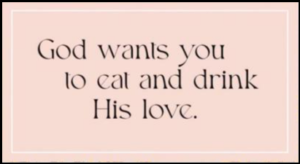 For the past two years, we’ve been unpacking the Gospel of Matthew.
For the past two years, we’ve been unpacking the Gospel of Matthew.
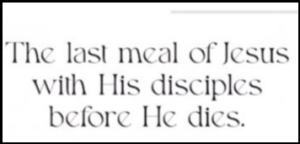 Today, we arrive at the start of the climax:
Today, we arrive at the start of the climax:
Everything we read so far led to this point in the story:

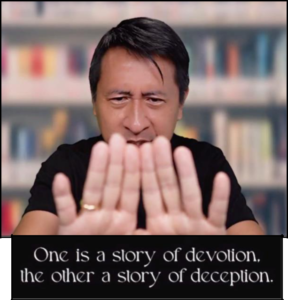 Two Stories
Two Stories
Matthew juxtaposes or placed two opposing stories side by side. One is a story of devotion, the other a story of deception. Last week, we read the story of Mary of Bethany who loved Jesus so much, she anointed Him with extravagant perfume.
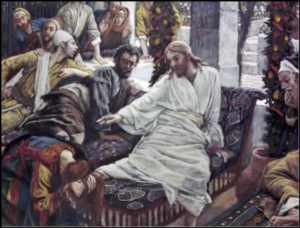 But in today’s story, Judas exchanged Jesus for 30 denarii. How much is that? A denarius is a daily wage in ancient times. So, in modern Philippines, 30 denarii would be about P15,000. Yes, Judas sold Jesus for the price of an entry-level mobile phone.
But in today’s story, Judas exchanged Jesus for 30 denarii. How much is that? A denarius is a daily wage in ancient times. So, in modern Philippines, 30 denarii would be about P15,000. Yes, Judas sold Jesus for the price of an entry-level mobile phone.
 Lesson? Wise people give up everything to follow Jesus; Foolish people give up Jesus for loose change.
Lesson? Wise people give up everything to follow Jesus; Foolish people give up Jesus for loose change.
Perhaps Matthew wants us to ask ourselves: Are you Mary or are you Judas? Do you give up everything for Jesus? Or do you give up Jesus for what turns out to be nothing?
I know I become Judas when I give up Jesus for my pride. Or my lust. Or my greed.
A friend of mine hooked up with the wrong girl. He knew from day one she was bad news. This person was not going to bring him closer to God. But he was very attracted to her. And so, he gave up Jesus for her.
Two years later, he came to me a broken man, regretting his choice.
Remember this Truth: The 30 denarii are not worth it.
Don’t exchange Jesus. Period.
Jesus Died on the Passover—Here’s Why
Let’s go to the core story of today’s reading: The Passover Meal.
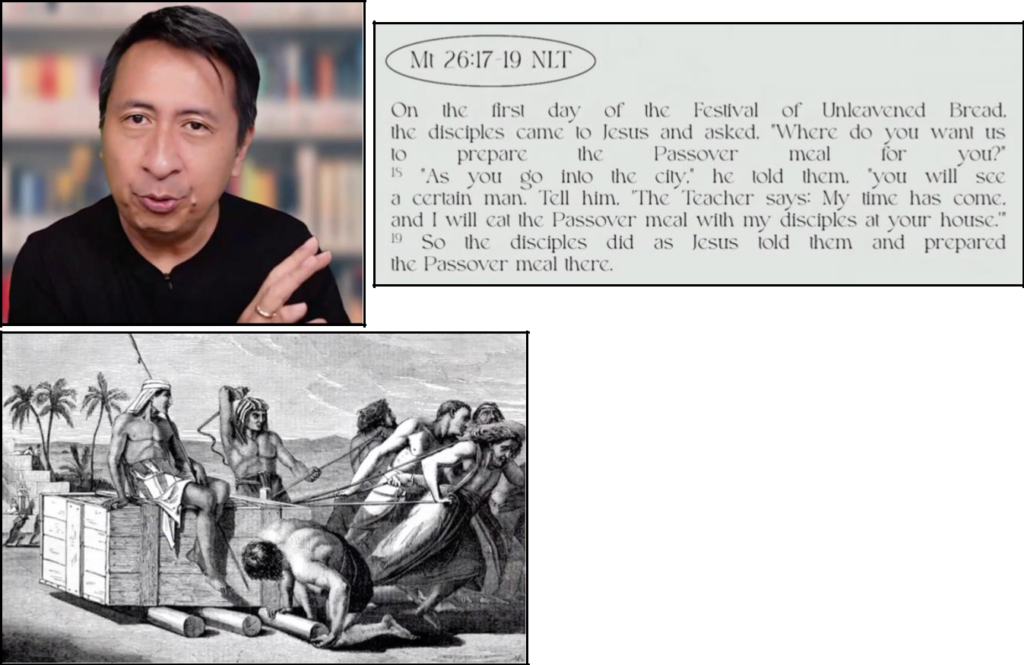
The Festival of Unleavened Bread is another name for Passover.
A little explanation of a Passover meal: Passover is the biggest feast of the Jews because it’s their origin story. Once upon a time, they were a bunch of slaves in Egypt, suffering under the cruelty of Pharaoh. But God rescued them and made them a great nation.
In the reading, it gives you this sense that Jesus planned their Passover meal very well. Including the fact that it was done one day earlier.
This is clearer in the Gospel of John, but even in Matthew, when he said, “On the first day of the Festival”. Bible scholars believe that this was the sunset of the previous day. Because that’s how Jews counted their days. It always starts at sunset. Why celebrate it one day earlier? Jesus knew that by this time tomorrow, He’d already been hanging on a dirty cross.
My point?

Because He wanted to tie these two events together—what God did in the first Passover, and what God will do through His death, is the same– but much, much greater.
God Is Vulnerable to You
Let’s go on:
Question:
If an acquaintance betrays you, it doesn’t hurt as much. But if it’s a really close friend, it hurts deeply.
Jesus must have been hurt deeply by the betrayal of Judas. He was part of the 12, His inner circle– someone He worked, traveled, and lived with for three long years.
Fact: Our deepest wounds come from people we love. Because we drop our defenses only with the people we trust.
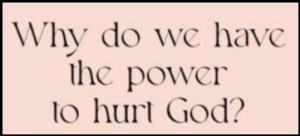 I have always wondered why we have the power to hurt God.
I have always wondered why we have the power to hurt God.
 Now I know. When God relates with us, He drops His defenses.
Now I know. When God relates with us, He drops His defenses.
He becomes vulnerable.
He brings us into His inner circle and trusts us with His heart.
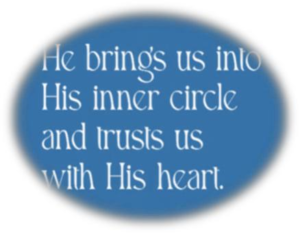
Is Jesus Simply a Teacher?
We continue:
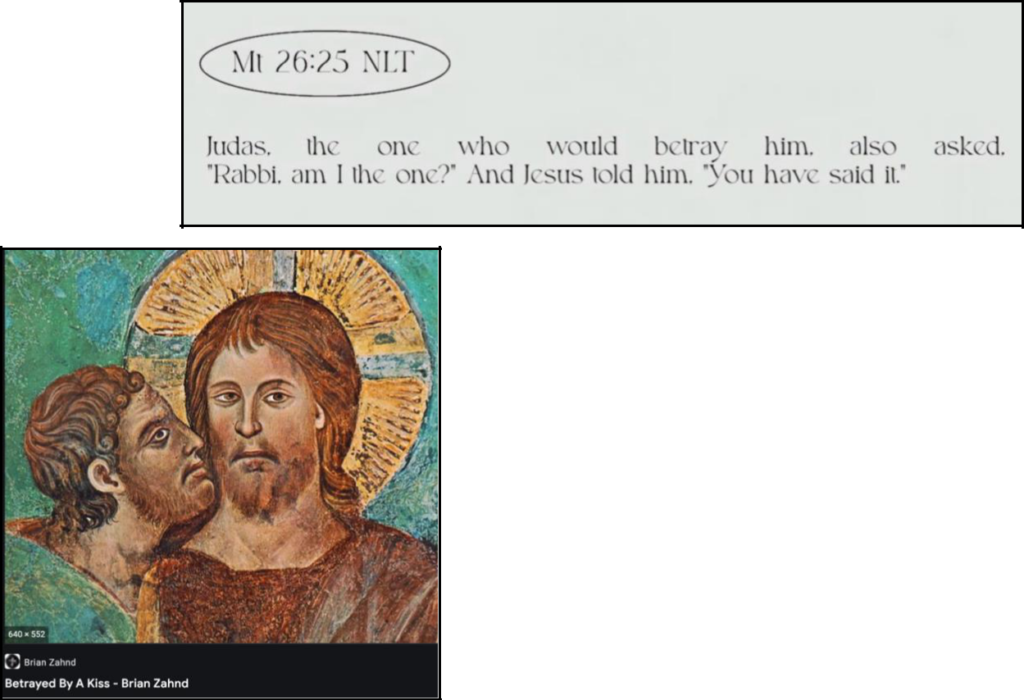
Judas called Him Rabbi.
This is the first time in Matthew a disciple called Jesus Rabbi.
Every other time, disciples called Him Lord.
Only outsiders called Him Rabbi.
Perhaps, this is Matthew’s question:
Will you simply listen to Him?
Or will you obey Him?

Teaching Made Edible
 Jesus was going to die.
Jesus was going to die.
In Matthew, He predicted it three times. But His disciples were still confused.
Why should He die?
How will His death benefit anyone? For obvious reasons, they wanted Jesus alive. They needed Him alive and powerful, so He can oust the Romans. They couldn’t fathom why He had to die.
May I insert this truth? We don’t understand it, either.
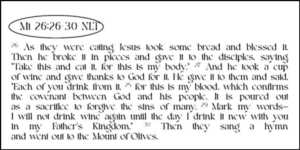 Even to this day, if you ask a Catholic, “How does the death of Jesus save you?”
Even to this day, if you ask a Catholic, “How does the death of Jesus save you?”
Many will stutter and repeat lessons they heard from their religion classes.
How we wish Jesus wrote a book to explain it all: The Doctrine of My Death and Why It’s Good for You— Written by Jesus Christ.
Or since He’s God anyway, Jesus could have recorded a video of Himself giving a theological discussion of salvation. If not a video, a podcast would have been fantastic too.
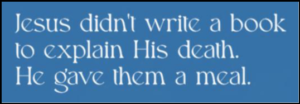 But here’s what happened.
But here’s what happened.
Jesus didn’t write a book to explain His death; He gave them a meal.
The meal was the explanation of His death.
The Most Photographed Dinner in the World
Let me describe to you what happened in that Passover meal.
We may not know the details, but we have a broad idea because the ritual was passed on from generation to generation.
I want you to imagine the disciples with Jesus, not seated in a straight line like in Leonardo da Vinci’s The Last Supper painting which was how banquets were done in Leonardo da Vinci’s time…
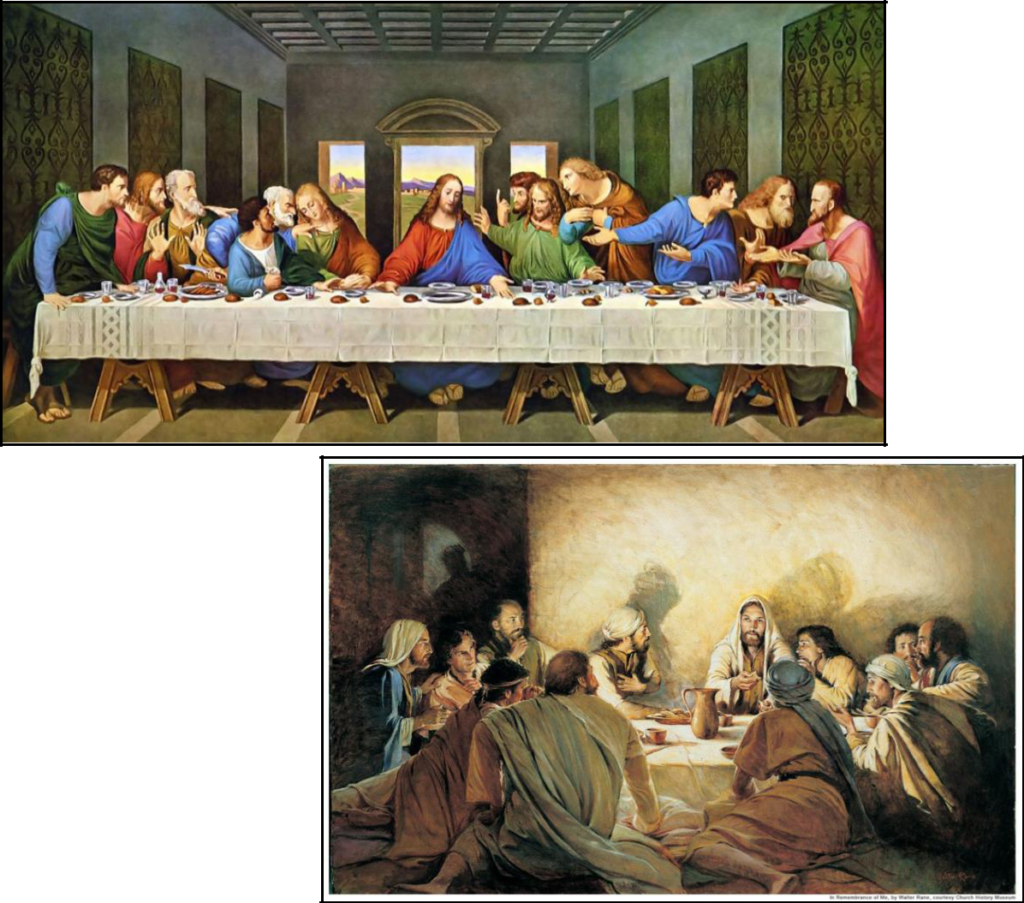
…but as how they ate in that part of the world 2000 years ago, lying on their side, propping themselves with their elbows on a shallow table.
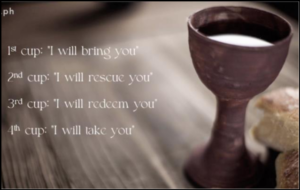 The Passover meal had four cups of wine, each cup moving the ceremony from one part to the next. So, the cups were the structure of the meal.
The Passover meal had four cups of wine, each cup moving the ceremony from one part to the next. So, the cups were the structure of the meal.
Each time, the father of the family said the customary blessing, “Blessed are you, Lord our God, king of the world, who has created the fruit of the vine.”
Throughout the meal, there would be rituals like karpas, which is the dipping of vegetables in saltwater— saltwater being a symbol of their bitter tears; they also ate the maror or the biter herb, symbolizing the pain and bitterness of their slavery.
After the second cup, there’s a little drama. The youngest person in the family would ask the oldest person, “Why are we doing this?”
And the elder would retell the story of the cruelty they suffered under Pharoah’s rule and how God stood up to Egypt with the nine plagues: water turning to blood, frogs, lice, flies, livestock pestilence, boils, hail, locusts, darkness. Plus a 10th: the killing of firstborn children.
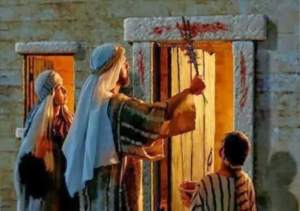 He would then say that on the night of their escape, every firstborn in Egypt would die. But the Israelites were saved by the blood of a lamb. God told them to kill a lamb and place its blood on the doorposts of their houses. When they do that, death will “pass over” their houses and not touch them.
He would then say that on the night of their escape, every firstborn in Egypt would die. But the Israelites were saved by the blood of a lamb. God told them to kill a lamb and place its blood on the doorposts of their houses. When they do that, death will “pass over” their houses and not touch them.
Note: This was a pure gift. Because God did not just protect the most religious Israelites. He protected everyone who trusted Him.
This was their origin story that Jews would remind themselves of again and again every year.
But in the middle of the Passover meal, Jesus does something shocking…
This Is Awful
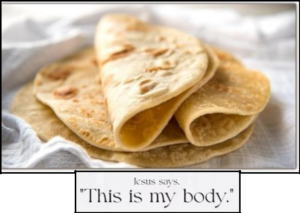 Jesus takes unleavened bread.
Jesus takes unleavened bread.
Why unleavened? Because the Jews were in a hurry that night, they had no time to wait for the yeast to make the loaves rise. They were in a hurry because they were going to escape from Egypt that night.
Jesus takes the bread and blesses it, but He says something very disturbing.
He says, “This is my Body.”
As Catholics, we hear it in the Mass so often, we don’t realize how awful that sounds.
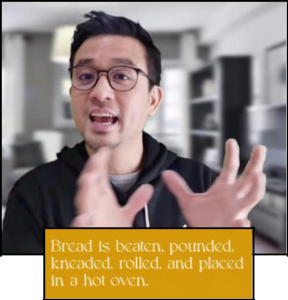 Imagine if I said, “Hey, this cookie is my body. I made it with my flesh. Please enjoy.”
Imagine if I said, “Hey, this cookie is my body. I made it with my flesh. Please enjoy.”
Yuck. That’s horrible.
But what is bread but something that’s beaten, pounded, kneaded, rolled, and placed in a hot oven? Just a few hours after the meal, that was what was going to happen to the body of Jesus.
Yes, Jesus was going to die. But bread also means life. Bread nourishes you. In the same way, Jesus’ death nourishes you.
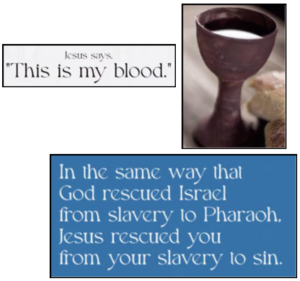 Then Jesus takes the cup, and He shakes them up again by saying something horrific.
Then Jesus takes the cup, and He shakes them up again by saying something horrific.
He says, “This is my blood.”
Who in his right mind would want to drink His blood?
But this was not just any blood– this was the blood of the covenant. He was using the same language from the first Passover, where the lamb’s blood became the symbol of God’s protection.
In the same way that God rescued Israel from slavery to Pharaoh, Jesus rescued you from your slavery to sin.
But wait . . .
The Missing Lamb
The strangest thing is that when the Gospels retell the Passover meal, there was no mention of the lamb. But if you’re a Jew, this is very strange.
That’s as strange as the story of Fr. Erik Santos, priest presider in LOJ Masses in the early 2000…
Fr. Erik said he was born in a poor family in Tondo. One day, it was his birthday.
And his mother asked him to blow the candle, saying, “Anak, bago mo i-blow ang candle, mag-wish ka.”
And little Erik made a wish and blew the candle. The mother asked him, “Anak, ano ang wish mo?”
“Ang wish ko,” little Erik said, “sa susunod na birthday ko, sana hindi lang kandila… sana may birthday cake na ako.”
In the same way that a birthday needs a cake, Passover needs a lamb. But when Jesus celebrated the Passover meal, there was no lamb.
The apostles must have been whispering to each other, “Gee, are our donations so low, we can’t afford to buy a lamb?”
But there was no lamb on the table because Jesus was already the Lamb of God. As gross as this may sound, the host was also the food. In just a few hours, Jesus was going to die. So that spiritual death will “pass over” us.
 Through The Meal, You Won’t Just Understand It…
Through The Meal, You Won’t Just Understand It…
I repeat: Jesus could have explained His death logically. Intellectually. Rationally. Using 7 bullet points with 18 footnotes. He didn’t. Instead, He fed people with a special meal that was already woven in the heart of the Jewish people for two thousand years. For every Jew, it meant freedom. Deliverance. God’s favor. But Jesus reshapes the meaning of the meal by inserting Himself as the sacrificial Lamb.
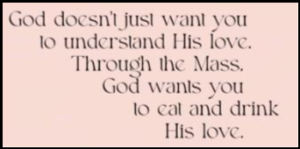 God doesn’t just want you to understand His love; Through the Mass, God wants you to eat and drink His love.
God doesn’t just want you to understand His love; Through the Mass, God wants you to eat and drink His love.
My dear friend, every time you celebrate Mass (even if it’s online), see yourself as one of the disciples. Sit around the table of the Last Meal. See Jesus at the head of that table.
And hear Him say, “This is My Body; This is My Blood.”
Yes, Jesus invites you to the greatest meal that will last forever.
Dear friend, God is madly in love with you.
He loves you so much, He fought for you to the point of death.
Respond to His love today!
